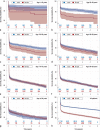ST-Elevation Myocardial Infarction as a First Event
- PMID: 35314025
- PMCID: PMC9437838
- DOI: 10.3238/arztebl.m2022.0161
ST-Elevation Myocardial Infarction as a First Event
Abstract
Background: Survival after ST-elevation myocardial infarction (STEMI) as a first event in Germany was analyzed.
Methods: Adults with a first-event STEMI were included for analysis on the basis of insurance data from a German health insurance provider (AOK; approximately 26 million members; median follow-up 48.5 months). The primary endpoints were 30-day mortality, reinfarction or death, major adverse cardiovascular and cerebro - vascular events (MACCE), long-term survival for more than 90 days, and overall survival (OS).
Results: STEMI occurred in 17 444 patients (32.8% women). The women were older than the men (median age 74 versus 60 years) and suffered more frequently from cardiovascular comorbidities such as diabetes mellitus, chronic renal disease, and arterial hypertension. Women underwent endovascular or surgical treatment less frequently, but sustained complications (cardiogenic shock, resuscitation) more frequently. After adjustment of the data, women were at higher risk of 30-day mortality (odds ratio [OR] 1.17, 95% confidence interval [95% CI] [1.07; 1.28]), reinfarction or death (hazard ratio [HR] 1.09, 95% CI [1.04; 1.16]), MACCE (HR 1.09, 95% CI [1.04; 1.15]), and poorer OS (HR 1.10, 95% CI [1.04; 1.17]). This effect was especially pronounced in women aged ≤ 60 years. No differences between the sexes were seen among patients who survived for 90 days after the infarction.
Conclusion: In Germany, women ≤ 60 years display a higher 30-day mortality after first-event STEMI, which affects their overall survival. Younger women should receive intensified medical attention after STEMI, especially in the early phase.
Figures




Similar articles
-
Sex disparities in guideline-recommended therapies and outcomes after ST-elevation myocardial infarction in a contemporary nationwide cohort of patients over an eight-year period.Atherosclerosis. 2023 Jun;375:30-37. doi: 10.1016/j.atherosclerosis.2023.05.007. Epub 2023 May 11. Atherosclerosis. 2023. PMID: 37245424
-
Clinical predictors of patient related delay in the VIENNA ST-elevation myocardial infarction network and impact on long-term mortality.Eur Heart J Acute Cardiovasc Care. 2017 Apr;6(3):254-261. doi: 10.1177/2048872616633882. Epub 2016 Feb 17. Eur Heart J Acute Cardiovasc Care. 2017. PMID: 26888787
-
Are there sex differences in the effect of type 2 diabetes in the incidence and outcomes of myocardial infarction? A matched-pair analysis using hospital discharge data.Cardiovasc Diabetol. 2021 Apr 22;20(1):81. doi: 10.1186/s12933-021-01273-y. Cardiovasc Diabetol. 2021. PMID: 33888124 Free PMC article.
-
Culprit Vessel-Only Versus Multivessel Percutaneous Coronary Intervention in Patients With Cardiogenic Shock Complicating ST-Segment-Elevation Myocardial Infarction: A Collaborative Meta-Analysis.Circ Cardiovasc Interv. 2017 Nov;10(11):e005582. doi: 10.1161/CIRCINTERVENTIONS.117.005582. Circ Cardiovasc Interv. 2017. PMID: 29146672 Review.
-
Factors Affecting Early Mortality and 1-Year Outcomes in Young Women With ST-Segment-Elevation Myocardial Infarction Aged Less Than or Equal to 45 Years.Curr Probl Cardiol. 2021 Mar;46(3):100419. doi: 10.1016/j.cpcardiol.2019.03.008. Epub 2019 Mar 30. Curr Probl Cardiol. 2021. PMID: 31047713 Review.
Cited by
-
Association between neutrophil to high-density lipoprotein ratio and no-reflow after coronary intervention: A cross-sectional study.Medicine (Baltimore). 2025 Jan 24;104(4):e41352. doi: 10.1097/MD.0000000000041352. Medicine (Baltimore). 2025. PMID: 39854761 Free PMC article.
-
Impact of Guideline-Directed Drug Therapy after ST-Elevation Myocardial Infarction on Outcome in Young Patients-Age and Sex-Specific Factors.J Clin Med. 2024 Jun 27;13(13):3788. doi: 10.3390/jcm13133788. J Clin Med. 2024. PMID: 38999354 Free PMC article.
References
-
- Yeh RW, Sidney S, Chandra M, Sorel M, Selby JV, Go AS. Population trends in the incidence and outcomes of acute myocardial infarction. N Engl J Med. 2010,;362:2155–2165. - PubMed
-
- Townsend N, Wilson L, Bhatnagar P, Wickramasinghe K, Rayner M, Nichols M. Cardiovascular disease in Europe: epidemiological update 2016. Eur Heart J. 2016,;37:3232–3245. - PubMed
-
- Regitz-Zagrosek V, Oertelt-Prigione S, Prescott E, et al. Gender in cardiovascular diseases: impact on clinical manifestations, management, and outcomes. Eur Heart J. 2016,;37:24–34. - PubMed
MeSH terms
LinkOut - more resources
Full Text Sources

